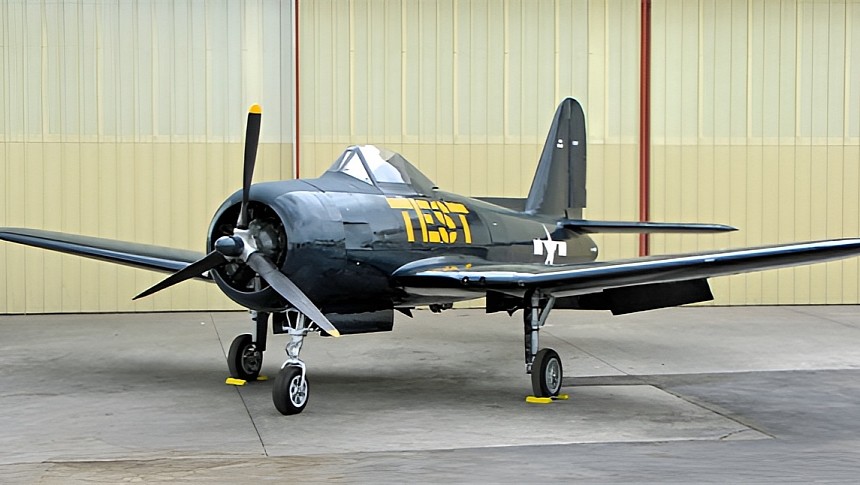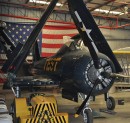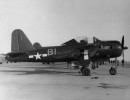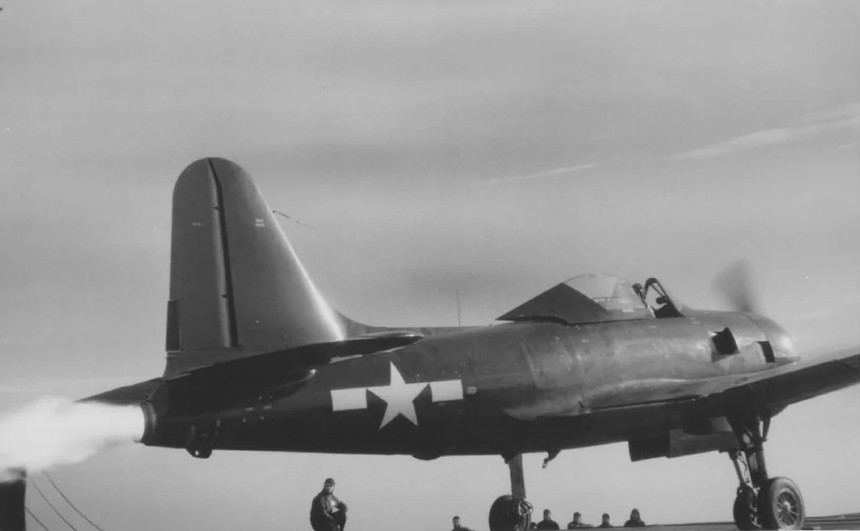Even in 2023, when people think of a hybrid, they immediately think of the Toyota Prius and probably not much else. But at its root, a hybrid drivetrain isn't bound to mundane Lithium-ion batteries and pitiful little gas engines they assist. In the dog days of World War II, the U.S. Navy had an entirely different, considerably more badass take on a hybrid drivetrain. Not in a car, mind you, but in an airplane. This is the story of the Ryan FR-1 Fireball, the U.S. Navy's piston-jet hybrid.
Allow us to paint the scene for you. The year is 1943, and as we speak, the Brits, Americans, Free French, Canadians, and a handful of others are huddled together in a building in England, planning the D-Day invasion of Normandy. Meanwhile, U.S. forces and their allies in the Pacific Theater were gearing up for a massive counteroffensive island-hopping campaign in the wake of their victory over Imperial Japan at the Battle of Midway. While all this chaos was taking place, a Navy Admiral by the name of John S. McCain Sr, the grandfather of the future U.S. Senator from Arizona, John McCain III, was facing a peculiar dilemma.
Admiral McCain couldn't help but be intrigued by rapidly developing advancements in gas turbine engine technology spurred on by the British aero engineer Sir Frank Whittle. It was Whittle, through his self-founded Power Jets company, who supplied the blueprints to U.S. engineers to allow the Yanks to begin their own domestic jet engine program. It was because of the Power Jets W.1 and the upgraded W.2 that the U.S. was able to manufacture its first jet engine, the General Electric I-A. Over time, the prototype I-A became the General Electric J-31 engine, America's first production-scale turbojet engine.
But there was a problem, specifically when it came to the application of jet-powered aircraft in an aircraft carrier setting. You see, early jet engines weren't exactly powerhouses in terms of raw thrust generated. Considerable time was needed for early turbine engines to spool up to maximum power output. That's a real issue when you only have a few hundred feet of carrier deck and a meager hydraulic catapult to help coax an airplane into the sky. What Admiral McCain desired most of all was a Navy-specific aircraft with the traditional takeoff, landing, and cruising characteristics of a piston airplane, with the ability to quite literally turn on the jet when the time came for combat.
In the end, the Navy selected the Ryan Aeronautical firm of San Diego, California, to develop and manufacture this novel jet-piston hybrid airplane for the sole purpose of being trialed onboard American aircraft carriers. What resulted was initially dubbed the XFR-1. In some ways, this new bird appeared similar to contemporary piston fighters of the day but radically different in others. For starters, the XFR-1's tricycle landing gear might appear normal by modern standards. But in the 1940s, only a handful of airframes utilized this format. With dimensions of just over 32 feet (9.7 m) long with a 40-foot even (12.2 m) wingspan, the XFR-1 was similar in size to contemporary piston Navy fighters of the day like the Grumman Hellcat, Vaught Corsair, and Supermarine Seafire.
As for the drivetrain, the XFR-1 utilized a single Wright R-1820 Cyclone nine-cylinder radial engine cranking 1,350 horsepower for takeoff, cruising, and landing purposes. Had the type ever seen combat, the rear-mounted General Electric J-31 would've been switched on, giving a considerable 1,600 lb (7.1 kN) thrust boost to the aircraft. With the benefit of using the same type of aviation gasoline, both engines were fed from the same twin self-sealing fuel tanks, reducing the need for wing-mounted drop tanks in most situations. That said, Ryan Fireballs often flew with at least one underwing drop tank, which could be replaced with up to two 1000-lb (454-kg) bombs or eight five-inch unguided rockets to compliment a suit of four M2 Browning machine guns mounted in sets of two in either wing.
Speaking of the wings, the XFR-1s were the first to be designed with a laminar flow in a carrier-based setting. Similarly to land-based fighters like the North American P-51 Mustang, these wings were designed to cut through turbulent high-speed air with minimal resistance. This translated to a top speed of 404 mph (650 kph, 351 kn) with both engines at full throttle and an impressive service ceiling of 43,100 ft (13,100 m), which was verified during the XFR-1's flight testing.
Testing began in earnest when the first FR-1 made its inaugural flight on June 25th, 1944, less than 20 days after the successful D-Day invasion. But almost immediately, problems with the rivets on the wings put the program in jeopardy. As was discovered, the wing rivets on all three FR-1 Fireballs from the first production batch were wholly inadequate and resulted in the loss of all three airframes. With an order from the U.S. Navy for 700 FR-1s pending, this was an issue on a number of levels. This potentially catastrophic issue was resolved only after the number of rivets on each wing was effectively doubled.
Upgraded variants of the FR-1 came in short order after the type's first flight. The first upgrade dubbed the XFR-2, utilized a more powerful 74W variant of the Wright Cyclone engine, making 1,425 hp with a single example manufactured. Further upgrades came with the XFR-4, with the J31 turbojet replaced with a more powerful Westinghouse J34. The resulting engine swap added an extra 100 mph (161 kph) to the airframe's top speed, bringing its performance more in line with contemporary pure-jet fighters of the day like the German Me-262 and Gloster Meteor, at least on paper.
A new, bespoke U.S. Navy fighter squadron was formed on New Year's Day 1945, dubbed the Fighter Squadron 66 (VF-66), for the purpose of trialing the Fireball. The squadron received the first of their aircraft in March of that year and potentially even conducted the first jet engine-only carrier landing when one of Fireball's Cyclone piston engines failed. This feat is widely disputed, as it's unknown whether any residual power from the piston engine was still propelling the aircraft. Had twin atomic bombings by the Americans and concurrent invasion by the Soviets not brought an end to the Pacific War, it's possible that FR-1s could have engaged Japanese fighters over the skies of an invasion of the Japanese mainland.
But alas, for the Fireball, the war ended before such an event could take place. At the same time as the end of the war, work was beginning on the first generation of pure-jet fighters designed specifically for aircraft carrier service in the form of the McDonnell F-2 Banshee and the Grumman F9F Panther. There was at least one more attempt to bring the Fireball airframe back into relevancy by replacing its piston engine outright with a General Electric T31 turboprop engine and calling it the XF2R Dark Shark. Only a single example was produced, as the Dark Shark was unable to match the performance of the Banshee and Panther, respectively.
By 1947, the Ryan FR Fireball platform and all its variations had been retired. Today, only a single example of an FR-1 Fireball remains on display at the Planes of Fame Museum in Chino, California, less than a two-hour drive away from where this novelty of an airplane left the factory almost eight decades ago. Though not all that successful in its own right, the Ryan Fireball did at least prove in no uncertain terms that the era of piston engine dominance in the skies over a battlefield was well and truly at its end. For this reason, it's safe to claim the residual effects from the Ryan Fireball program were far more long-lasting and considerably more memorable than the plane itself was. Sometimes, that's just how the cookie crumbles.
Admiral McCain couldn't help but be intrigued by rapidly developing advancements in gas turbine engine technology spurred on by the British aero engineer Sir Frank Whittle. It was Whittle, through his self-founded Power Jets company, who supplied the blueprints to U.S. engineers to allow the Yanks to begin their own domestic jet engine program. It was because of the Power Jets W.1 and the upgraded W.2 that the U.S. was able to manufacture its first jet engine, the General Electric I-A. Over time, the prototype I-A became the General Electric J-31 engine, America's first production-scale turbojet engine.
But there was a problem, specifically when it came to the application of jet-powered aircraft in an aircraft carrier setting. You see, early jet engines weren't exactly powerhouses in terms of raw thrust generated. Considerable time was needed for early turbine engines to spool up to maximum power output. That's a real issue when you only have a few hundred feet of carrier deck and a meager hydraulic catapult to help coax an airplane into the sky. What Admiral McCain desired most of all was a Navy-specific aircraft with the traditional takeoff, landing, and cruising characteristics of a piston airplane, with the ability to quite literally turn on the jet when the time came for combat.
In the end, the Navy selected the Ryan Aeronautical firm of San Diego, California, to develop and manufacture this novel jet-piston hybrid airplane for the sole purpose of being trialed onboard American aircraft carriers. What resulted was initially dubbed the XFR-1. In some ways, this new bird appeared similar to contemporary piston fighters of the day but radically different in others. For starters, the XFR-1's tricycle landing gear might appear normal by modern standards. But in the 1940s, only a handful of airframes utilized this format. With dimensions of just over 32 feet (9.7 m) long with a 40-foot even (12.2 m) wingspan, the XFR-1 was similar in size to contemporary piston Navy fighters of the day like the Grumman Hellcat, Vaught Corsair, and Supermarine Seafire.
Speaking of the wings, the XFR-1s were the first to be designed with a laminar flow in a carrier-based setting. Similarly to land-based fighters like the North American P-51 Mustang, these wings were designed to cut through turbulent high-speed air with minimal resistance. This translated to a top speed of 404 mph (650 kph, 351 kn) with both engines at full throttle and an impressive service ceiling of 43,100 ft (13,100 m), which was verified during the XFR-1's flight testing.
Testing began in earnest when the first FR-1 made its inaugural flight on June 25th, 1944, less than 20 days after the successful D-Day invasion. But almost immediately, problems with the rivets on the wings put the program in jeopardy. As was discovered, the wing rivets on all three FR-1 Fireballs from the first production batch were wholly inadequate and resulted in the loss of all three airframes. With an order from the U.S. Navy for 700 FR-1s pending, this was an issue on a number of levels. This potentially catastrophic issue was resolved only after the number of rivets on each wing was effectively doubled.
Upgraded variants of the FR-1 came in short order after the type's first flight. The first upgrade dubbed the XFR-2, utilized a more powerful 74W variant of the Wright Cyclone engine, making 1,425 hp with a single example manufactured. Further upgrades came with the XFR-4, with the J31 turbojet replaced with a more powerful Westinghouse J34. The resulting engine swap added an extra 100 mph (161 kph) to the airframe's top speed, bringing its performance more in line with contemporary pure-jet fighters of the day like the German Me-262 and Gloster Meteor, at least on paper.
But alas, for the Fireball, the war ended before such an event could take place. At the same time as the end of the war, work was beginning on the first generation of pure-jet fighters designed specifically for aircraft carrier service in the form of the McDonnell F-2 Banshee and the Grumman F9F Panther. There was at least one more attempt to bring the Fireball airframe back into relevancy by replacing its piston engine outright with a General Electric T31 turboprop engine and calling it the XF2R Dark Shark. Only a single example was produced, as the Dark Shark was unable to match the performance of the Banshee and Panther, respectively.
By 1947, the Ryan FR Fireball platform and all its variations had been retired. Today, only a single example of an FR-1 Fireball remains on display at the Planes of Fame Museum in Chino, California, less than a two-hour drive away from where this novelty of an airplane left the factory almost eight decades ago. Though not all that successful in its own right, the Ryan Fireball did at least prove in no uncertain terms that the era of piston engine dominance in the skies over a battlefield was well and truly at its end. For this reason, it's safe to claim the residual effects from the Ryan Fireball program were far more long-lasting and considerably more memorable than the plane itself was. Sometimes, that's just how the cookie crumbles.











